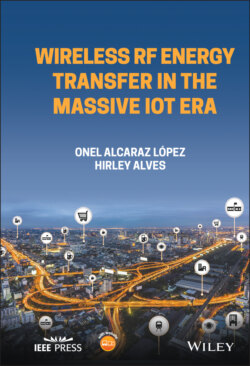Читать книгу Wireless RF Energy Transfer in the Massive IoT Era - Hirley Alves - Страница 9
ОглавлениеPreface
Why We Wrote This Book
Even though there is vast literature on radio-frequency energy harvesting and wireless energy transfer, the majority of the works do not focus on Internet of Things network deployments and their inherent characteristics and stringent requirements, particularly, the need to support the operation of a massive number of low-power low-cost devices. Powering this massive number of devices is challenging and cannot be done by adapting conventional models designed for a limited number of users. Massive Internet of Things networks will connect thousands to millions of devices in a single cell.
The lack of dedicated solutions prompted us to research in this area, which we call “massive wireless energy transfer” (massive WET). We then decided to gather the most recent contributions on massive radio frequency energy harvesting and compile the information into a single reference that can serve as a guide for future research in this revitalized area. This book reviews the state-of-the-art in radio frequency energy harvesting and points out future research directions. A basic background in statistics and wireless communications is sufficient to read this book, while some basic knowledge of linear algebra, convex optimization, and statistical signal processing may be needed to thoroughly follow the main theoretical derivations and analysis.
Structure of the Book
The book is divided into eight chapters. In a nutshell, Chapter 1 and Chapter 2 introduce the key concepts and provide an overview of the energy harvesting technologies in the context of massive networks. Then, Chapters 3 to 7 delve into analytical and algorithmic aspects of the different protocols, techniques, and scenarios examined in each chapter. Finally, Chapter 8 summarizes the key contributions of each chapter and indicates future research directions.
In Chapter 1, we overview the concept of massive IoT and related connectivity components. Chapter 2 is an overview of the energy harvesting technology based on radio frequency energy transfer for powering future low-power massive network deployments. In Chapter 3, we focus on ambient radio frequency energy harvesting techniques, which exploit readily available environmental radio frequency energy, and review key protocols and scenarios. Then, in Chapter 4, we delve into massive wireless energy transfer, in which energy transmissions from dedicated energy sources energize a massive number of energy harvesting devices, and propose novel energy transfer mechanisms tailored for massive Internet of Things networks. In Chapter 5, we concentrate on a network of power beacons, which are dedicated radio frequency energy transmitter devices. Therein, we discuss and propose optimization approaches for the deployment of a network of power beacons. Next, Chapter 6 discusses the wireless-powered communication network architecture, key characteristics, protocols, and single and multi-user scenarios with respective power control strategies. Chapter 7 overviews the simultaneous wireless information and power transfer architecture, the main receivers, and representative scenarios. Finally, Chapter 8 summarizes the key contributions of this book and indicates future research directions.
How to Use This Book
Researchers who want to delve into the field of radio frequency energy harvesting can read this book from cover to cover. Chapter 1 provides the motivation and introduction to general ideas discussed in the book. Chapter 2 is instrumental to understanding the underlying analytical models used in the remaining chapters. Therefore, after reading Chapter 2, Chapters 3, 4, 6 and 7 can be read in any order, based on personal preference. Even though Chapter 5 can be read independently, it relies on concepts introduced in Chapter 4.
Each chapter ends with a summary of the key points and contributions. A researcher familiar with the broad field of radio frequency energy harvesting can read the summary and become acquainted with the content, and then decide to read in detail.
Onel Alcaraz López and Hirley Alves
Oulu, May 2021
